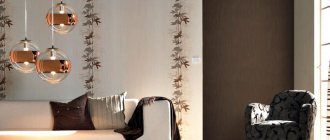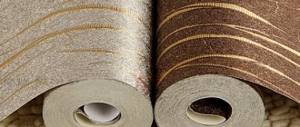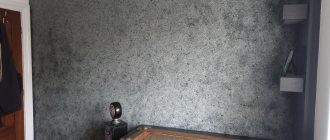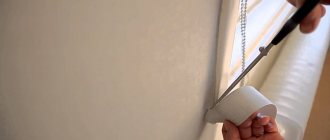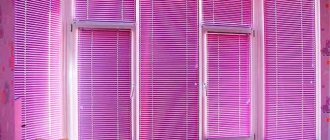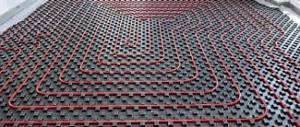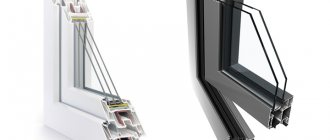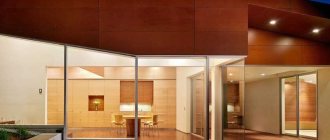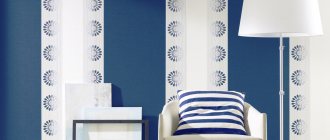Despite the variety of finishing materials for walls, wallpaper remains the most popular and popular option. This is due to certain points that make them stand out against the background of other materials.
Today there are various types of this finish, but it is worth highlighting two types - vinyl and non-woven. They are presented in a huge range of colors and with various designs. They can be used to decorate almost any room, but it is worth knowing the difference between vinyl wallpaper and non-woven wallpaper. This will allow you to carry out high-quality repairs that will retain its original appearance for a long time.
Factors influencing the choice of wallpaper
There is a difference between non-woven wallpaper and vinyl. It is important to first study all the characteristics of the two types in order to purchase the most suitable finishing material. The correct choice of finishing material determines how accurately it will be possible to recreate the intended interior. When making renovations in various rooms, it is very important to consider some basic points:
- room area;
- wall material;
- microclimate;
- exploitation.
All factors are directly related to the choice of finishing material, since for one type of finishing the conditions will be ideal, but for another they will be simply disastrous and in the worst case, repairs will have to be carried out again immediately or after a very short period of time.
Vinyl wallpapers
The first difference between non-woven wallpaper and vinyl is the number of layers they consist of. Vinyl sheets consist of two layers, for the first one they use woven material or paper. The second decorative layer is made of artificial material polyvinyl chloride. In addition, the canvas can be impregnated with a special substance at the factory, which prevents the formation of fungus and mold. This is a huge advantage since it is possible to use them in rooms with high humidity levels.
Vinyl wallpaper has a very wide range of uses. This is primarily due to their technical characteristics. The main advantages of this type of finishing include the following:
- very high levels of resistance to mechanical stress; scratches, sunlight and even direct contact with water;
- special impregnation against the formation of fungi and mold;
- some manufacturers offer finishing materials with micropores, which in turn improves air exchange;
- foam texture will hide even significant imperfections in the wall surface;
- huge selection of colors and textures.
But it is also worth noting some of the disadvantages of this type of finishing material. First of all, many may have a question regarding their environmental safety, since their base is made of polyvinyl chloride. This is absolutely true, but there is no need to worry about safety, PVC is used everywhere today, and its production has been brought to high levels. The main thing when choosing a finishing material is to give preference to manufacturing companies that can provide all quality certificates regarding their products.
Vinyl wallpaper
Vinyl wallpaper consists of two layers: the base layer is made of paper or fabric, the top layer is made of PVC film. This is because the adhesive cannot be absorbed into the vinyl film and will not hold the covering to the wall. To do this, a porous substrate is thermally attached to it, which absorbs the adhesive well and holds the entire canvas on the wall. Hence one of the disadvantages: the large weight of the sheets.
Vinyl wallpaper has a number of advantages that make it a serious competitor to non-woven wallpaper:
- a large number of colors and patterns - either the film can be painted or an additional layer with a printed pattern can be added;
- images retain color for a long time - PVC protects against fading and abrasion;
- moisture resistance – the coating reliably protects the paper layers and the wall from moisture;
- easy to clean - any dirt can be simply wiped off with a damp cloth;
- anti-vandal properties - some vinyl models have a thick coating, so they are not afraid of the pampering of children or the claws of animals.
Creative ideas for covering a kitchen apron
In this article we will talk about the most popular materials for facing an apron.
Because of these characteristics, vinyl-coated wallpaper is used in bathrooms, bathrooms, kitchens and hallways. However, it is better not to use them in children's rooms, living rooms, bedrooms and other living rooms: due to the film layer, the walls will not breathe, there will be a greenhouse effect in the room, and mold may appear under the coating.
Such wallpapers are difficult to apply: due to their greater weight, they require glue with special additives that improve adhesion to the wall. Also, to ensure even distribution of the material, it is difficult to glue them alone.
Let's look at the "competitor" and try to conclude which wallpaper is better to choose - vinyl or non-woven.
Features of non-woven wallpaper
Before answering the question: which wallpaper is better, vinyl or non-woven, it is worth studying their main characteristics.
As for non-woven ones, they will appeal to those who prefer materials of natural origin. Today you can find non-woven wallpaper on a paper basis. This option will have characteristics that correspond precisely to the characteristics of the material that is used as the base.
If we talk about non-woven wallpaper without a base, then only non-woven wallpaper is used for their production and they can rightfully be called one-component. The production technology is similar to the production of simple paper webs. In order to make a pattern on the canvas, hot stamping technology or pattern printing is used. The surface of the fabric is velvety to the touch. The undeniable advantages of this finishing material include the ability to “breathe”, which creates an excellent microclimate in the room.
Non-woven wallpaper is very popular among consumers, this is due to several factors, including:
- long service life of about 10 years;
- possibility of applying a layer of paint on top;
- preliminary surface preparation is minimal;
- keep their shape well (if the gluing work is done correctly);
- minor wall defects are hidden.
There are also disadvantages, but they are not related to the quality of the products. The only disadvantages include the relatively high cost and limited range. It is also worth protecting walls covered with such wallpaper from aggressive mechanical influence.
In which rooms is it better to use vinyl, non-woven and paper wallpaper?
When choosing wallpaper, you should focus not only on the preferences of the owner, but also on the purpose of the room whose walls you plan to cover.
Hallway
The walls of the hallway are the most vulnerable. Coming in from the street, we bring dust and dirt with us, undressing, often touching the walls of our outerwear, taking off our shoes, often leaning on the walls to maintain balance. We leave a lot of objects in the hallway - bags, skis, bicycles, rollerblades - the proximity to them does not always leave a mark on the wallpaper.
Not every wall covering can withstand such harsh operating conditions. Therefore, wallpaper for a hallway must be durable, abrasion-resistant, and allow for intensive wet cleaning. Hot stamping vinyl wallpapers satisfy this stringent requirement. But wallpaper made of foam vinyl is not suitable for a hallway: its porous structure will become clogged with dirt. Paper and non-woven ones are also not suitable for the corridor, unless, of course, you want to update them regularly.
Kitchen
The kitchen is another problematic room. Constant temperature fluctuations, steam swirling over boiling pots, soot, splashes flying in different directions every now and then... In addition, the kitchen is considered a high-traffic area, which means that the likelihood that someone will accidentally tear or accidentally scratch the wallpaper is higher here, than in living rooms.
When looking for wall coverings for such a room, you should first pay attention to wallpaper made of hard vinyl. They are quite durable, and, in addition, they are easily removed from dirt that is common in the kitchen. It is highly undesirable to cover the kitchen with paper or non-woven wallpaper, or foam vinyl wallpaper - they simply will not withstand such operating conditions and will quickly become unusable.
Living room
When choosing wallpaper for the living room, you can finally forget about practicality and think about beauty. You can give preference to foamed vinyl or silk-screen printing, or you can stick cheaper, but no less aesthetically attractive paper wallpaper. And if you want something exclusive, opt for paintable non-woven wallpaper.
Bedroom
We spend quite a lot of time in the bedroom, gaining strength before a new working day, so the choice of wallpaper for this room must be approached with all responsibility. The surface of the walls here is not subject to mechanical stress, which means there is no particular need for durable wallpaper. Give preference to environmentally friendly materials that are as close to natural as possible - paper or non-woven fabric.
Children's
The main requirement for materials for decorating a children's room is harmlessness. The baby spends most of his time here, and all the micro-emissions of toxic and allergenic substances emitted by low-quality wallpaper will go to him. But he will definitely want to taste this beauty. The ideal option for a child's room would be child-safe paper or non-woven wallpaper.
Moreover, it is better to give preference to the first. The child will inevitably paint them with felt-tip pens, cover them with plasticine, and test the coating for strength. And if simple and inexpensive wallpaper suffers from such “creativity,” parents will treat this without unnecessary tragedy. And when the child grows up, you and him will choose something more sophisticated.
You might be interested
Distinctive characteristics
The question often arises of how to distinguish non-woven wallpaper from vinyl. In some cases this is quite difficult. If the canvases are already glued to the wall, then you can only understand what material is by touch. Natural non-woven wallpaper will be much nicer and with less pronounced relief. If the comparison takes place in a store before purchasing, then first of all you should pay attention to the thickness of the canvas. Foamed vinyl on any base will be an order of magnitude thicker and more massive than thin one-component non-woven fabrics. If you are not confident in your own abilities when choosing a finishing material, you should contact an experienced consultant who can fully provide all the necessary information.
Wallpapering
The technology for gluing vinyl wallpaper directly depends on the type of base. If it is a paper canvas, then the glue is applied to the canvas itself and then applied to the wall. If the base is different, then the adhesive composition must be applied only to the wall, while the wallpaper is applied dry.
As for non-woven wallpaper, when gluing, the glue is applied only to the wall. This somewhat simplifies the process. It is worth remembering that this type of wallpaper is not so durable and can tear if there is a need to tear it off the wall and stick it again. Therefore, it is important to carry out the work very carefully and consistently to avoid any corrections.
Which wallpaper is best for the bedroom and which for the kitchen is a matter of individual decision. Vinyl trim is more practical and can withstand harsh conditions. They can even be stuck in the bathroom. For the bedroom and especially the children's room, it is worth choosing one-component non-woven options. This is primarily due to their naturalness, which is especially valued in our time.
Breathable non-woven fabric
Non-woven fabric is a natural material made from cellulose fibers. It is used along with dublerin to strengthen parts when sewing clothes. It is very light, soaks well in liquids, is very flexible and holds its shape. These properties were taken into account when creating non-woven wallpaper - a combination of a layer of non-woven fabric and one or more layers of paper.
What are its advantages over vinyl:
- light weight - any wallpaper glue will do;
- easy to stick - the adhesive composition is applied to the wall, and a piece is applied to it;
- relief surfaces - a large number of models with embossed reliefs, which allows you to hide unevenness;
- does not tear when cracks occur in the walls, but stretches across all layers - for example, during shrinkage;
- possibility of painting: most of the wallpapers “for painting” are non-woven;
- breathe - the structure allows air to pass through.
Liquid wallpaper: pros and cons
Wall decoration in an apartment or office is one of the “pain points” of modern renovation.
How to achieve beautiful and high-quality wall coverings without much effort and with minimal financial and labor costs? An excellent option is liquid wallpaper. For these reasons, the best rooms for such coverings are children's rooms, bedrooms and living rooms. The main disadvantage of such wallpaper is its high price. Their range of images and colors is lower than that of vinyl or paper. They easily become victims of pets, get wet and do not tolerate all types of contaminants - some are quite difficult to wash off.
